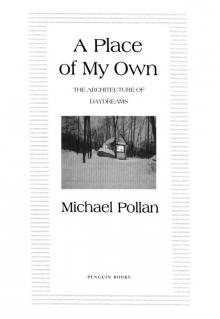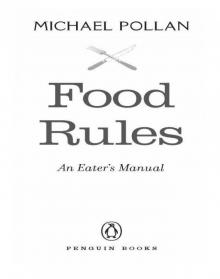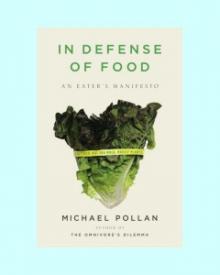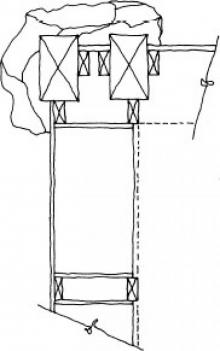- Home
- Michael Pollan
Cooked: A Natural History of Transformation Page 9
Cooked: A Natural History of Transformation Read online
Page 9
It was time to start cooking. While Ed supervised, Aubrey and I lifted the split hogs onto big sheet trays, carrying them as if on stretchers into the kitchen. The sink was long enough to accommodate an entire split pig, and we began by washing down the carcasses with water, trimming stray bits of fat, and removing any blood. (“You never want to eat blood,” Ed explained. The injunction is biblical: Blood is the animal’s soul, and that belongs exclusively to God.) The pigs were heavy—about seventy-five pounds each half—and extremely slippery when wet. The first time I tried to hoist my end out of the sink after we’d rinsed it, I lost my grip. The pig fell to the floor and had to be rinsed all over again, a humiliating start to my barbecue career.
The four pits, which occupied one long wall of the kitchen, were built out of brick and resembled the ones in Ayden, except that they had sleek, stainless-steel covers and a sophisticated system for ventilating the smoke. Ed was very proud of the kitchen’s design, which included a redundant ventilation system and sprinklers that allowed him to safely and legally bring wood-burning barbecue pits into a restaurant kitchen—the first time, he claimed, this had ever been done in North Carolina.
Ed was happy to give orders and let me work. I never did figure out whether he had decided I had some potential as a pitman, or was just happy to have someone else do the heavy lifting. He handed me a shovel and told me to remove the ashes from the floor of the pits, ashes probably left over from the last barbecue Ed cooked here, before the foreclosure in 2004. What he instructed me to do next came as a surprise, and a disillusioning one at that. He asked me to empty two twenty-pound bags of charcoal into the center of each pit. Ed cooked with Kingsford!—those little rectangular black pillows of compressed charcoal made from sawdust and who knows what else. How authentic is that? Ed explained that Kingsford gave him a long, slow burn that “allowed me to get some sleep at night.” But it was tasteless! What about the wood smoke? “You’ll see in due course.”
After I mounded the briquettes in the center of each pit, Aubrey squirted copious amounts of lighter fluid onto them, waited a moment for it to soak in, and tossed a match that instantly ignited an impressive conflagration. This wasn’t exactly the primordial fire I’d come in search of. It was more like the suburban backyard barbecue blazes of my childhood. Everyone, it seems, makes his own compromises, whether in the interest of convenience or cost, but everyone else’s compromises are abominations. Though I uncovered a reservoir of mutual respect between the Joneses and Mitchells, the former regards Mitchell’s charcoal as a sad declension, and the latter feels the same way about the Joneses’ commodity pigs. (“I would say they’re eighty percent of the way there,” Ed told me.)
While we waited for the briquettes to catch fire and then mellow, Ed showed me around the building, parts of which had been leased to a woman who was operating it as a cafeteria. The structure was a somewhat bewildering warren of rooms that had been added on, piecemeal, to the original mom-and-pop grocery store. The former store survives as the comparatively tiny, windowless heart in the middle of what has grown into a sprawling cinder-block complex. Proudly, Ed showed me the upstairs lecture hall, where he had planned to start a barbecue college for aspiring pit masters; the “pig bar,” where customers could have a drink while watching Ed or Aubrey chop barbecue; and the dining room, the walls of which were covered with a remarkable mural depicting the role of barbecue in Southern history. It was an ambitious piece of folk art, at least fifty feet in length, and painted over the course of a few years by an autistic man who worked in the kitchen as a dishwasher. (It took me the longest time to realize Ed was not saying an “artistic man,” which seemed self-evident.) “He offered to do the whole thing for ten dollars,” Ed told me. “That didn’t seem right, so I gave him twenty dollars and bought the paint.”
Ed made sure I looked at every scene closely. The mural depicted a myth of the origins of barbecue in the traditions of the tobacco harvest. Its theme was community. You saw carts laden with tobacco; men stripping the big leaves, women poling them, then handing the long poles to men to hang in the barn; wood fires burning in the barns to cure the tobacco; men slaughtering hogs outside, hanging their carcasses from trees; women making sausages and soap from the lard; men digging the barbecue pits, which looked like fresh graves, and passing jars of moonshine. And then the climactic scene: On a broad lawn in front of a big white mansion, an improbably long table stretches out in the shade of a great oak. This is the site of the celebratory feast that marked the end of the harvest.
“Now look at the faces of the people at that table: black and white. Together. This was practically the only time that happened back then. We needed each other and everyone knew it, even if we went back to our separate lives afterward. But whether you were picking cotton or putting in the tobacco, everyone worked together and then everyone feasted together at a barbecue.”
Ed spoke of the tobacco harvest as if it had been part of his own childhood, but his nostalgia was for a world that was already fading into myth by the time he was a boy. (His parents left the land in 1946, the year he was born.) Yet such memories don’t necessarily have to be in the first person to shape our lives. For Ed, the mural underscored what was most meaningful to him about barbecue: that it brought people together as a community, and that, even if only temporarily, it transcended race. As far as he is concerned, it still does.
“There’s something about cooking a whole animal that makes people feel happy. It’s usually a special occasion, a celebration of some kind, and it never fails. Barbecue brings people together, it always did and always will. Even in the sixties, during the race movements, barbecue was one of the things that held down the tensions. At a barbecue, it didn’t matter who you were.
“Only two things in my experience have had the power to transcend race: Vietnam and barbecue. There’s no other dish that powerful. And don’t ask me why, because I don’t know.”
Ed appeared to grow melancholy as he showed me around the building, much of which felt hastily abandoned. I asked him to tell me how he’d lost Mitchell’s Ribs, Chicken & Barbecue.
Though it wasn’t something he could prove, Ed was convinced that his outspokenness on the subject of industrial hog farming had led directly to his troubles.
“We held a press conference here in Wilson in 2004, and John T. came up and spoke. We announced the A&T project with the farmers, and my plans for bringing natural pigs back into barbecue. I didn’t think anything of it at the time, but two men I didn’t recognize stood up and asked me, very grumpily, ‘Are you trying to start something?’
“‘No, I’m not trying to start anything.’
“‘Oh yes, you are. You’re getting ready to tell people not to buy my product, and that isn’t good.’”
Thus began what Ed refers to as a period of “orchestrated turbulence.” Within weeks of the press conference, he claims, the state launched an audit of his books, which quickly turned into an investigation. Then the bank suddenly notified him he was in foreclosure. Soon after that he was charged with embezzlement. True, Ed had fallen behind on his payments, both to the bank and the state, but the speed and severity of the actions taken against him seemed suspicious.
“In less than thirty days of my press conference, I had my business closed and was charged with embezzlement. The arraignment was all over the television and newspapers. I can only think it was an orchestrated effort to ruin Ed Mitchell’s reputation, because I had become a viable spokesman for an alternative kind of product.” Ed Mitchell had become a threat to one of the state’s most powerful industries—industrial hog farming—and was raising uncomfortable questions—questions of authenticity—about one of its proudest t
raditions: whole-hog barbecue.
But is this really what happened? I talked to people in Raleigh who don’t buy Ed’s version of events, and believe that his troubles stemmed from his business failings, nothing else. Others aren’t so sure. John T. Edge, for his part, thinks it entirely plausible that Ed was the victim of a campaign to discredit him. “Here was a black man in North Carolina telling people he was cooking the best barbecue in the state and promoting an alternative to the commercial hog industry. I’m sure there are some people in North Carolina who thought Ed Mitchell had gotten uppity and needed to be taken down a peg.”
Since the time of his troubles, Ed has taken pains to tone down his rhetoric about the commercial hog industry. He speaks more about “the chef’s personal taste” in pork and less about the evils of agribusiness. But he has also received a partial vindication: A judge ruled that the bank had improperly foreclosed on Mitchell and did not have “clean hands.” The ruling came too late to do Mitchell much good, however. Mitchell’s Ribs, Chicken & Barbecue is no more, and it may be that Ed’s travails will stand as the exception to the lovely rule that barbecue never fails to bring people together.
When we got back to the kitchen, the coals were ready, glowing red and dusted with white ash. Ed handed me the shovel again and explained how to properly bank the coals: You arrange them in the rough outline of your pig, a six-inch-wide line of coals all around except at the top and bottom, beneath the butt and shoulders, which, being thicker, need more fire. There, you want more like twelve inches of coals. Ed then took an oak log that had been soaking in vinegar and tossed it on the coals. That one log would supply all the smoke the pig would need. Now Aubrey and I each took one end of the big grates, placed them over the pits, and then lifted the split hogs onto the grates, skin side up; we would flip them in the morning. I began to lower the covers over the pigs, but Ed stayed my hand.
“This is where I like to stop and salute the pigs. They’ve given the ultimate sacrifice so that people can eat, and we should at least acknowledge that.” He gave them each a fond little pat on the ham, the kind of affectionate butt-pat athletes give one another. Then he lowered the steel covers over the pigs and closed down the vents, and that was it. We were done for the night.
Over the course of our conversations, Ed had gone back and forth on the relative difficulty and mystery of his art. More than once he had alluded tantalizingly to “trade secrets,” but other times he disclaimed there were any such thing. This was one of those times. “It’s hard work, but there’s really nothing all that complicated about making good barbecue.” Which might be the deepest, darkest secret of all.
When the three of us reconvened in the kitchen at seven the next morning, you could tell immediately that something had changed. The chemical scent of lighter fluid was gone, replaced by the seductive aromas of roasting meat. Something very good was going on under those stainless-steel pit covers. I lifted one of them and marveled at the transformation: What had been a flabby white carcass was now a considerably smaller side of pork with a deep, rich color and some muscle tone. Its skin was gorgeous: lacquered brown, the color of strong tea. The animal was still leathery to the touch, though now its flesh put up some resistance, like cooked meat. It wasn’t quite done, but I couldn’t wait to taste it.
So what exactly had happened in the night, to transform these more or less odorless, flaccid hunks of hog flesh into delicious-smelling and -looking meat? How was it that some burning coals and a single oak log had turned something you would never think to eat—dead pig—into something you couldn’t wait to eat?
Actually, a great many things had happened in the night, transformations both physical and chemical. The heat had driven off much of the water in the meat, altering its texture and concentrating its flavors. It had also rendered much of the substantial layer of fat directly under the skin. Some of that fat had dripped onto the hot coals and turned into smoke, sending up a whole range of aromatic compounds that rejoined the surface of the meat, adding new layers of flavor. But because the pork was cooking at such a low temperature, much of the back fat had slowly melted into the meat, helping to keep it moist and adding its own rich flavor to the muscle, which in the absence of fat has relatively little flavor of its own. The muscle fibers themselves had undergone a transformation, as the heat broke down the collagen that bound them together, turning it to gelatin, which tenderized and further moistened the meat.
Chemically, what had been simple the fire had rendered complex. According to a flavor chemist I consulted, putting smoke and fire to the proteins, sugars, and fats in meat creates anywhere between three thousand and four thousand entirely new chemical compounds, complex and often aromatic molecules forged from the simple building blocks of sugar and amino acids. “And those are just the compounds we can name; there are probably hundreds more we haven’t identified.” In this, cooking, even though it may start by breaking things down, is the opposite of entropy, erecting complex new molecular structures from simpler forms.
Several different chemical reactions are responsible for these creations, but one of the most important is the one named for the French doctor who identified it in 1912: Louis-Camille Maillard. Maillard discovered that when amino acids are heated in the company of sugar, the reaction produces hundreds of new molecules that give cooked food its characteristic color and much of its smell. The Maillard reaction is responsible for the flavors in roasted coffee, the crust of bread, chocolate, beer, soy sauce, and fried meats—a vast amount of chemical complexity, not to mention pleasure, created from a handful of amino acids and some sugar.
The second important reaction working on our pigs during the night was caramelization. The heating of odorless sucrose until it browns generates more than a hundred other compounds, with flavor notes reminiscent not just of caramel but also of nuts, fruits, alcohol, green leaves, sherry, and vinegar.
Together these two reactions produce a vast encyclopedia of scents and flavors. The question that arises is, why should it be that we prefer this complexity to the comparatively monochromatic flavor of uncooked meat? Richard Wrangham would say it’s because evolution has selected for humans who happened to like the complex flavors of cooked foods; those who did ate more of it and produced more offspring. Harold McGee, the food-science writer, proposed another intriguing theory in his 1990 book, The Curious Cook. He points out that many of the aromatic compounds generated by the two browning reactions are similar or identical to compounds found in the plant world, such as the flavor notes that we think of as nutty, green, earthy, vegetal, floral, and fruity. It might be expected that caramelizing sugars would produce some of the same compounds found in ripe fruit, since fruits contain sugars; however, it is curious to find so many phytochemicals—plant compounds—showing up in something like roast meat.
“The mingling of the animal and vegetable, the raw and the cooked, may seem like a remarkable coincidence,” McGee writes, and it is. But it makes sense that this particular canon of scents would move us, since it is the one we encountered every day in the world of edible plants long before we discovered how to cook. In that uncooked world, this particular group of aromatic compounds amounts to a kind of universal interspecies language, one of the principal systems of communication between plants and animals. Already familiar, those plant scents and flavors were precisely the ones you did well to pay attention to, since they could direct you to good things to eat and away from bad.
Plants have become, by necessity, the great masters of biochemistry in nature. Rooted in place, they evolved the ability to manufacture these aromatic compounds because chemistry can do for the plants what locomotion, vocalization, and consciousness do for animals. So the plants pr
oduce molecules that warn and repel and poison some creatures, and others that attract them, whether pollinators to assist them with reproduction or mammals and birds to move their seeds over distances. When their seeds are ready for transport, plants summon mammals with the strong scents and tastes of ripe fruit, a sensory language to which we have become particularly sensitive, since it alerts us to the presence of food energy—sugars—and other plant chemicals we need, like vitamin C. But all animals learn to operate in the information-rich chemical environment that plants create. Fluency in the molecular language of plants would have been particularly important for humans before the advent of agriculture reduced our diet to a small handful of domesticated species. When we still ate hundreds of different plant species, we relied on our senses of smell and taste to navigate a far more complicated food landscape.
So it is no wonder that those types of cooking (such as meat over fire) that happen to generate scents and flavors borrowed from the plant world’s extensive chemical vocabulary (and perhaps especially from the rich dialect of ripe fruit) would stimulate us as much as they do. They recall us to a time before agriculture, when our diet was far more diverse, not to mention more interesting and healthy.

 A Place of My Own: The Education of an Amateur Builder
A Place of My Own: The Education of an Amateur Builder Cooked: A Natural History of Transformation
Cooked: A Natural History of Transformation The Omnivore's Dilemma
The Omnivore's Dilemma How to Change Your Mind
How to Change Your Mind Food Rules
Food Rules In Defense of Food
In Defense of Food A Place of My Own
A Place of My Own